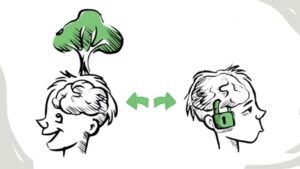The workplace is filled with various characters, ideologies, beliefs and cultures. However, there are 2 main types of mindsets found in every workplace; the fixed mindset and the growth mindset. In her book, Mindset: The New Psychology of Success, Dweck describes the simple, yet impactful differences between the two mindsets:

- Growth Mindset: People with a growth mindset believe abilities – like talent and intelligence – can be developed through dedication and hard work. They’re more likely to enjoy learning, seek out situations to experiment, and see failure as an opportunity to grow.
- Fixed Mindset: Those with a fixed mindset believe the opposite. They feel they “are who they are” and were born with a set level of talent, intelligence, and even interests. Because of this, they’re more likely to seek out opportunities and situations where these views are affirmed (like doing the same job over and over to receive praise) and believe that talent alone – not effort – is the source of success.
One thing that I have come to know over the years in the different corporate fields that I have worked is that, there is no skill in this world that cannot be learned. Once you put your mind to it and are willing to work toward it consistently and diligently, it soon becomes a part of you. The other thing I have come to know is that change is inevitable in life. I have been able to demystify the myths of people with fixed mindset and helped them overcome through coaching. And these people thought their mindsets were permanent! I have seen many of such people transform into growth mindset enough to know that change can never be fought against.
I have shared time and again with clients, and people I engage with that, just as we physically metamorphose from a foetus through childhood till the very last stage of adulthood, so does our mindset at every stage in our lives. The fixed mindset can always be changed so far as there is a willingness to try. As leaders, we must be mindful of how we tune our mindset and very careful in the way we nurture our team members in the workplace.
Techtello gives an insight to two types of leaders in the workplace: The one who believes in fixed abilities and promotes a fixed mindset “those who don’t perform well can never do better” and the other who believes in growing those abilities thereby promoting a growth mindset “people can be coached into improving their skills.”
The first kind engages with the workplace to boost their self-esteem, establish their superiority and prove their smartness. They focus on their employees’ weaknesses, refuse to coach them, blame others for failure, do not seek feedback, divide people into competent or incompetent and hire for natural talent instead of looking for ways to grow talent within their organization.
They praise people for their intelligence while failing to take notice of those who show improvement through effort and hard work. After all, their fixed mindset leads them with the belief that people can’t get any better and that makes them stick with their initial impression about them.
How can you spot them? You will often see them shutting down people and their ideas. They refuse to take responsibility for failures, discourage dissent, treat mistakes as a personal fault and give feedback that puts talent above effort.
The second kind engages with the workplace to create a learning environment providing development opportunities with focus on a high learning culture. They focus on their employees’ strengths, coach them into developing critical thinking skills, take responsibility for failures, engage with the conflict with the desire to gain knowledge, seek critical feedback to learn from criticism and hire people who show the desire to learn and grow. They invest in people and their growth since they believe that anyone can get better with the right kind of strategies, determination and persistence.
How can you spot them? You will often see their eyes light up with curiosity while listening to new ideas. They embrace challenges, offer advice to experiment, try harder and implement better strategies. They encourage difference of opinion, using failures and mistakes as valuable lessons to get better and give feedback that involves personal mastery. In other words, they help you become the best version of yourself.
What is the impact of this mindset on employees? Employees who work for growth mindset organizations where learning and growth is highly valued have far more trust in their company and a greater sense of empowerment and ownership. They are more committed to their companies and ready to go the extra mile for it. They welcome challenges, work harder, and persevere in the face of struggle which makes them more successful learners and better contributors to their organizations.
Which kind of leader or employee are you? It is obvious to see what happens with each mindset and how it affects the workplace. As a leader or employee, the high productivity you need for the goals and visions of your business, company or organization to come to fruition, can only become possible when a growth mindset is inculcated into the work culture and promoted actively.
Here are 4 points from rallybright to guide on the growth mindset journey:
- INCREASED PERSEVERANCE
It took Thomas Edison about 1,000 tries to perfect the lightbulb. Imagine what the world would look like if he stopped after the first try? We all want to get it right on the first try, but more often than not it takes many more than just one. A growth mindset is about achieving the best results from multiple iterations. This means encouraging team members to take educated risks without fear of failure or penalty.
Teach your team to try, then adjust based on their findings. A great number of experiments technically fail, but also lead to amazing results as people learn what not to do. By building the mental stamina to persevere, seemingly difficult tasks become easier. Your team won’t give up as easily, and as such are more likely to discover new and better ways of doing things.
For example, if your sales representative travels to a far-flung client only to fall short on their sales pitch, that does not mean they are a bad salesperson. Even though they may have prepared thoroughly for a client meeting, there are instances when it just does not work out. What is important is to learn from the experience in order to improve the next pitch.
A growth mindset reframes the entire situation to find the silver lining. Are there questions they can now anticipate for the next pitch, or communication skills they could sharpen? Promoting a growth mindset on your team means that team members are more likely to tackle problems head-on, embracing them as interesting challenges.
- GREATER CREATIVITY
Effective problem solving rests on exploring various avenues that can lead to success. It requires discipline, persistence and creativity. Creativity and growth mindsets go hand and hand with each other. When stuck on a problem at work, posing the question “how can I…” has a very different result than saying “I can’t do this.” Whereas one causes the mind to stop thinking, the other forces it to work harder to find alternatives. As our brains engage in divergent thinking, we become more creative.
Growth mindsets stimulate creativity by reframing situations to innovate through problems rather than remaining complacent. As employees experiment and brainstorm, there are ideas that may work and others that might not. In either case, creative exercises develop new neural pathways that have the potential to help solve future problems. The bottom line? A company that cultivates growth mindsets among its employees will always find ways to adapt and improve.
- MORE IMPACTFUL FEEDBACK
There is no such thing as a truly negative consequence when you have a growth mindset. Every result that stems from action is seen as a step in the right direction. Leveraging constructive feedback is a powerful tool for sharpening a growth-oriented team. In the workplace, leaders can accelerate the growth of employees by giving them constructive feedback – feedback that is encouraging in tone and given in the spirit of supportive professional guidance. Constructive feedback requires transparent communication between those giving and receiving it, and highlights both strengths and weaknesses. Celebrating successes and learnings while recognizing that there is always room for improvement encourages true growth and motivates team members.
- A CHANGE IN PERSPECTIVE
Adopting a growth mindset is a powerful step in maximizing your potential at work and in life. In essence, it is a change in perspective that acknowledges that growth is a journey more than a destination. So remember: success is not about how intelligent you are or what you know right now. It is about the self-directed growth that comes from taking action and learning about your individual strengths and vulnerabilities. Whatever you accomplish, you deserve to feel proud as you let your growth mindset guide you throughout your career.
Your perception affects the level of happiness and success that you are able to find in your personal life and career. Leaders and employees should therefore make sure the growth mindset is promoted because there is power in positive thinking.
Are you looking to get to know yourself better, whether you have a growth mindset or a fixed one and how to work on becoming better in the workplace? Then grab my book – The Essentials of Image Leadership which will become your personal workbook and guide you on your journey to a growth mindset.

Are ready to stand out and lead your Image?
Read my book: “The Essentials of Image Leadership”.
Designed with practical exercises for home or office,
This book gives you all the essential tips and
Tools needed to sail with success in your image.
It also touches on dining etiquette,
Ensuring that in every space you find yourself,
You make a personal impact and achieve influence.










